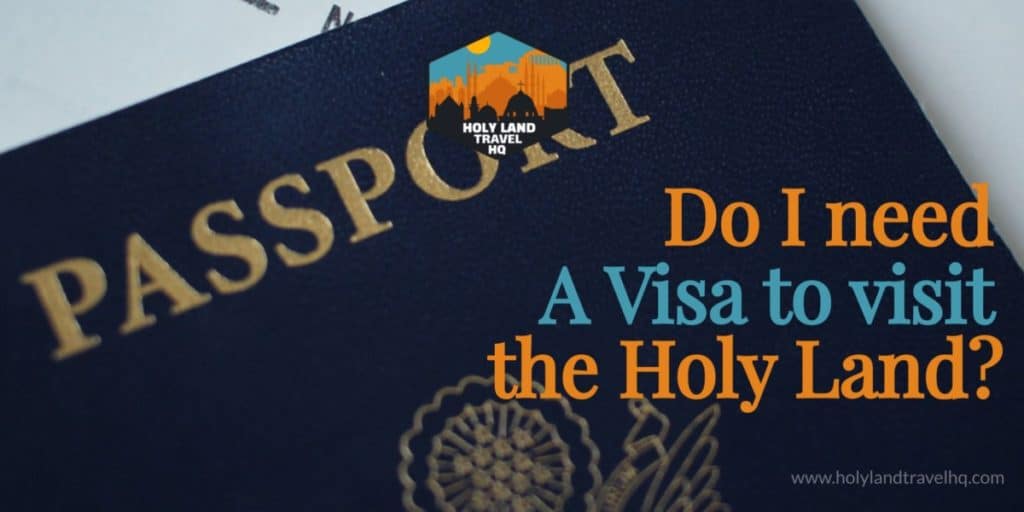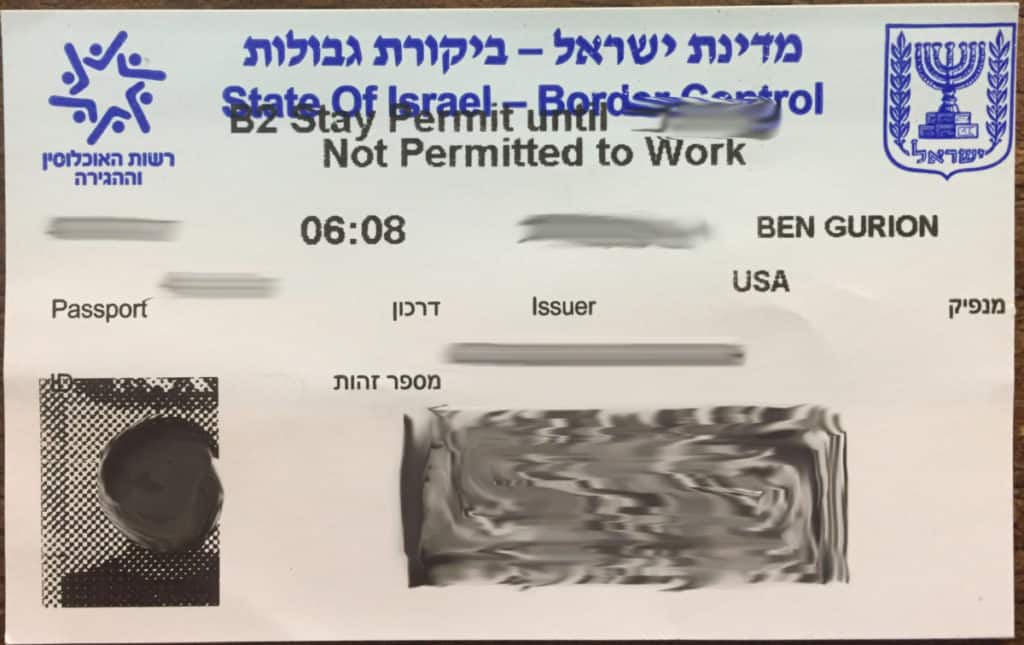
Planning your trip can be daunting, especially if you aren’t a planner. You have to find the right clothing. Get the right gear. Find transportation. Worry about lodging. And budget for food. The thing you don’t want to forget is a visa. A visa is an endorsement on your passport by the country you enter authorizing your visit for a certain period.
So, do you need a visa to visit the Holy Land? Yes. You will need a visa for Israel. You will also need a visa for Holy Land tours through Turkey, Jordan, and Greece. For most countries, visas are given at the point of entry. For others, you will have to apply for it. However, with the advent of the internet, that’s much easier today.
How to get a visa for Israel.
Israel issues tourist visas at the point of entry. For many of you, this will be Ben Gurion International Airport. Israeli customs does not stamp your passport. Instead, they will issue a paper visa.

The only requirement to get a visa is an official passport with an expiration date greater than 6 months from the date of entry. You will also need to fill out a visa application. They are provided at customs.
When you land at Ben Gurion International Airport, the customs agent will ask you some questions before issuing a visa. On a side note, when entering and exiting Israel, you will be asked a lot of questions, so be prepared.
You will be asked: why are you visiting Israel? Where are you staying? How long is your trip?
You may also be asked: Who is your tour guide? Where is your tour guide? How many people are in your group? What places will you be visiting? Will you be going to the West Bank?
Customs will then scan your passport into their system and take a picture of you. This photo will appear on your paper visa. There is no fee.
Some tours will include a short jaunt through Jordan. When returning, the process will be similar. The only difference is a visa fee will be applied.
For more information on visas and entry into Israel, check out what the US Department of State has to say right here (direct link to travel.state.gov).
Check out what the Israeli Minister of Foreign Affairs has to say about all types of visas right here . (Direct link to mfa.gov.il). Keep in mind, the information on the B/2 Visitors visa is for non-exempt countries. The United States has an exemption agreement with the State of Israel.
How to get a visa for Turkey
To obtain a Turkish tourist visa, you need to apply for one before your arrival. You can apply online through the Turkey Ministry of Foreign affairs website.
The process is fast and easy. You can apply for a visa and receive it on the same day. Often within the hour.
To apply for a Turkish tourist visa, go to the following link:
You will need your passport information, a credit card, and an email address. The system is finicky, and it’s recommended for applicants to use common email services like Yahoo!, Gmail, or Hotmail.
I’ve heard stories of people having issues with unique domain names or business email addresses. There is an email verification process that requires applicants to verify their email within a few minutes. With these unique domain email addresses, the verification request email from the Turkish Visa website can get delayed. By the time it arrives in the applicant’s inbox, the link has already expired.
So, use Yahoo!, Gmail, or Hotmail.
Sometimes the Turkish government can be a little high maintenance and change their prices. Their fussiness normally stems from diplomatic spats with other countries. A good price to pay for a visa is around $25 or $30.
When you apply, you will be asked for a start date. A tourist visa lasts for 90 days. I recommend a start date of 1 to 6 weeks before your departure date. If you need to change dates on your visa, you will have to get a new one.
Once you have the visa in your inbox, print it off and save the email. You will have to present the visa upon arrival.
For more information on visas and entry into Turkey, check out what the US Department of State has to say right here . (Direct link to travel.state.gov).
Getting a visa for Greece, Italy, and the Schengen Area.
If you are an American, you do not need to apply for a visa to get into Greece, or Europe. If you are a citizen of any other country, check out this link to the Greek Ministry of Foreign Affairs.
Look at the “Ordinary Passport” column. Scroll down to your country of citizenship. If it says “VISA-FREE,” then you don’t need to apply for a visa. Citizens of Hong Kong and Macao are at the bottom of the chart. They do not require a visa application.
Citizens of the United States and other “VISA-FREE” countries are authorized 90 days of travel upon entrance. The only requirement is for the traveler’s passport to have an expiration date more than 6 months out from the date of entry.
When you reach the point of entry, your passport will be stamped. You will then have 90 days to roam anywhere in the Schengen Area of Europe.
If the chart says “VISA” next to your country of citizenship, then you will need to get a Schengen Visa.
For more information on visas and entry into Greece, check out what the US Department of State has to say right here. (Direct link to travel.state.gov).
What is a Schengen Visa, and how can you get one?

In 1985, 26 countries within the European Union signed the Schengen agreement. Due to the size of Western Europe and the vast number of border crossings, traveling within the EU was difficult. It’s like driving up the East coast of the United States in a day. Except, before the agreement, travelers had to go through customs every time they crossed a border.
So, an agreement was brokered to remove the bureaucracy of “international” travel.
Because so many countries were giving up their sovereignty and border control, strict rules had to be established. Outside countries which entered into and agreed to certain diplomatic stipulations and travel regulations gained “VISA-FREE” status. Countries which posed refugee problems or did not agree to the terms became subject to Schengen visa requirements for their citizens.
The list of requirements is robust. It includes
- Proof of round-trip travel
- Proof of financial means to support the entirety of travel
- Proof of travel insurance, including health insurance.
- A valid passport with more than 6 months remaining before expiration
- Proof of accommodations
The best site I’ve found on Schengen Area and visa information is schengenvisainfo.com.
To see if your country is on the naughty list, click here. (Direct link to scgengenvisainfo.com).
For travel insurance, Schengenvisainfo.com recommends using axa-schengen.com or schengen.europ-assistance.com. Both sites offer two levels of short-term trip Schengen visa coverage. Axa-Schengen also offers a yearly plan for frequent travelers.
For more information on visas and entry into the Schengen Area, check out what the US Department of State has to say right here. (Direct link to travel.state.gov).
How to get a visa for Jordan
Some Holy Land tours will include or offer a short jaunt to Jordan. This excursion will often include sites like Petra and Mount Nebo.
At all points of entry, whether by air, land, or sea, US citizens can obtain a visa on site. It’s not common for Holy Land tours to fly into Jordan, though. Most tours will cross in the north at the Sheikh Hussein Bridge near Beit She’an, Israel. Or at the Yitzhak Rabin/Wadi Araba crossing near Eilat, Israel, and Aqaba, Jordan.
Visas at these two crossings are issued on site. There is some cost, though, which we’ll get to in a second.
Transferring from Israel to Jordan near Jericho at the Allenby Bridge/King Hussein crossing is rare. The crossing is mainly reserved for Palestinians traveling from Gaza to Jordan. Americans on travel can use this point of entry, though. The difference is that a visa must be applied for and obtained in advance.
There is a visa fee incurred at all Jordanian points of entry. It is roughly $56. Unlike many of the countries and locations covered in this post, a Jordanian tourist visa only lasts 30 days. A 60-day extension can be granted by going to a police station before the expiration date.
For more information on visas and entry into Jordan, check out what the US Department of State has to say right here. (Direct link to travel.state.gov).


